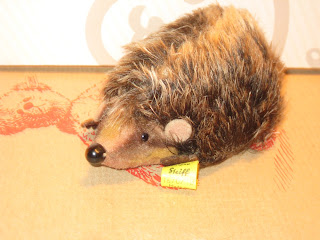"Hi,

I recently bought some old dolls, toys and a few Steiff animals from a woman who had them as a child in the 1950's.
I have not been able to identify a large white poodle anywhere online. He stands about 20" tall from paw to top of head and 20" long from head to tail. He has a jointed head only. He is mohair and dirty. He has a Steiff button in his right ear and a tag on one leg which is somewhat frayed. He is stuffed, but not soft.
Can you tell me anything about him?
Thank you!"
Wow, this is some rare, top dog worthy of a blue ribbon for sure! What a great "fetch!"
What Stephen h
 as so fortunately stumbled upon is an outstanding poodle that was made for one year only, in 1952. This precious pooch's name (like many of the Steiff poodles) is "Snobby". Snobby was produced in 17 and 28 cm in both black and white. He is made from wool plush, with a French trim (meaning a long mohair front and a short mohair rear), and has a swivel head. Because he is described as "hard stuffed", he is probably filled with excelsior, which is wood-wool shavings.
as so fortunately stumbled upon is an outstanding poodle that was made for one year only, in 1952. This precious pooch's name (like many of the Steiff poodles) is "Snobby". Snobby was produced in 17 and 28 cm in both black and white. He is made from wool plush, with a French trim (meaning a long mohair front and a short mohair rear), and has a swivel head. Because he is described as "hard stuffed", he is probably filled with excelsior, which is wood-wool shavings. There are three several things, besides his really limited appearance in the Steiff line, which make this poodle most interesting from a collector's perspective.
The first is the wh
 ite tag that Stephen mentions in his note. This is a US Zone tag, which shows that this poodle was made shortly after the factory in Giengen, Germany reopened after World War ll. This small white linen tag with black lettering appears (or appeared, it tends to get loved off) on all Steiff items produced between 1947 and 1953.
ite tag that Stephen mentions in his note. This is a US Zone tag, which shows that this poodle was made shortly after the factory in Giengen, Germany reopened after World War ll. This small white linen tag with black lettering appears (or appeared, it tends to get loved off) on all Steiff items produced between 1947 and 1953.The secon
 d is his rare button. As you can see, This Snobby poodle is sporting a very unusual "knopf im ohr" which has the word "Steiff" in raised in block capitals. (If you click on the picture it should enlarge...) This identification was only used from 1947 through 1952. To put things in perspective, Steiffgal only has 3 vintage Steiff items with this "all capitals" button out of a collection of several hundred vintage items.
d is his rare button. As you can see, This Snobby poodle is sporting a very unusual "knopf im ohr" which has the word "Steiff" in raised in block capitals. (If you click on the picture it should enlarge...) This identification was only used from 1947 through 1952. To put things in perspective, Steiffgal only has 3 vintage Steiff items with this "all capitals" button out of a collection of several hundred vintage items. And third is his name. This Snobby is the namesake grand-daddy of all Snobby poodles as he is the first and ORIGINAL Snobby in the Steiff line!
Steiffgal hopes that this second column on these handsome hounds has doubled your interest in Steiff poodles!
Have a question about one of your Steiff treasures? Let's talk! Click here to learn more.

























